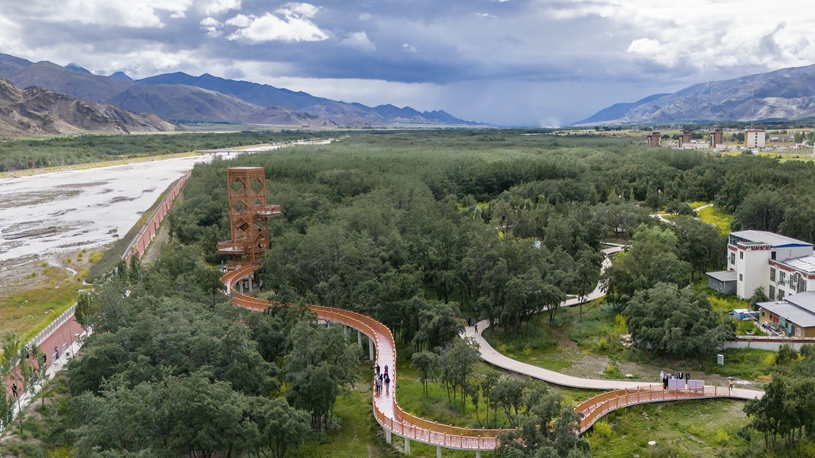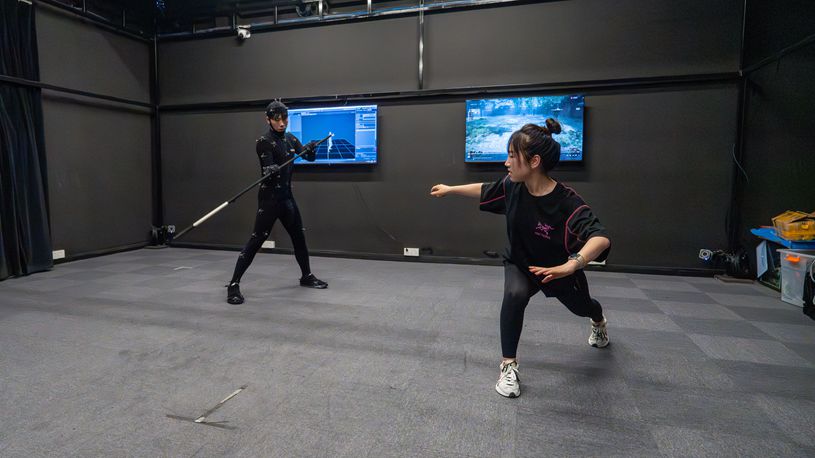Xinhua Headlines: Bridging global intelligence divide: China's solutions to making AI more inclusive
Source: Xinhua
Editor: huaxia
2025-07-29 01:37:31
* The 2025 World Artificial Intelligence Conference (WAIC) brought together representatives from around the world to explore avenues for the inclusive growth of artificial intelligence (AI).
* Numerous outstanding cases demonstrated how Chinese enterprises, from leading AI model developers to industrial innovators, are leveraging AI technologies to share the benefits of AI development with more countries.
* Building on its vision for inclusive AI development, China is actively promoting initiatives and alliances designed to consolidate, standardize, and promote global artificial intelligence cooperation.
SHANGHAI, July 28 (Xinhua) -- The 2025 World Artificial Intelligence Conference (WAIC), held from July 26 to 28 in Shanghai, brought together representatives from around the world to explore avenues for the inclusive growth of artificial intelligence (AI). China's approach offered insights into how AI can deliver shared benefits and help bridge the global intelligence divide.
Under the theme "Global Solidarity in the AI Era," the 2025 WAIC attracted over 1,500 guests from more than 30 countries and regions for in-depth exchanges and high-level forums. Featuring a record-breaking 70,000-square-meter exhibition, the 2025 WAIC unveiled over 3,000 AI innovations, including over 100 global and China-first debuts, showcasing a dynamic vision for global AI cooperation.
During the opening ceremony, several key initiatives and outcomes were announced, including an action plan for global AI governance, the International Open Source AI Cooperation Initiative, and the "AI from China·Benefits the World (2025)" case collection.
MOBILIZING GLOBAL WISDOM
At the main forum of the high-level meeting on global AI governance, global leaders reflected on the profound challenge of ensuring AI develops as a force for good rather than harm. Geoffrey Hinton, 2024 Nobel Laureate in Physics, underscored that one of humanity's greatest challenges is ensuring that intelligent AI systems are not only vastly capable but also continue to be aligned with human interests.
Hinton likened the development of such systems to raising a tiger cub, highlighting the importance of guiding AI behavior before it grows beyond our control. He stressed that no single nation can tackle the risks of advanced AI alone, and that building AI that is both powerful and subservient will require sustained global cooperation.
Echoing this view, a dialogue between former Google CEO Eric Schmidt and former Microsoft Executive Vice President Harry Shum explored how competition and cooperation must coexist in the AI era. Schmidt underlined the need for transnational cooperation to set rules for global competition and collaboration in AI.
This exchange embodies WAIC's broader mission to advance AI development that is inclusive, responsible, and beneficial for all humanity.
With vast data resources, diverse application scenarios, and surging market demand driven by accelerating digital transformation, China offers fertile ground for AI model training, iteration, and deployment, laying a strong foundation for global cooperation and scalable innovation, according to Gary Gu, technology consulting managing partner of EY Greater China.
On July 26, an action plan for global AI governance was released. The plan outlines concrete steps to foster open collaboration and inclusive innovation, encouraging bold experimentation, building international platforms for scientific and technological cooperation, and cultivating a pro-innovation policy environment.
It also calls for strengthened alignment in policy and regulation, and lower technical barriers to promote breakthroughs in AI technology innovation and widespread AI applications. Particular emphasis is placed on supporting countries in the Global South to develop AI technologies and services in line with their local needs, helping them genuinely access and apply AI.
INTERNATIONAL COOPERATION
At the 2025 WAIC, numerous outstanding cases demonstrated how Chinese enterprises, from leading AI model developers to industrial innovators, are leveraging AI technologies to share the benefits of AI development with more countries. This embodies China's commitment to ensuring that AI serves not only as a driver for technological advancement but also as a tool for fostering inclusive growth.
At iFLYTEK's exhibition area, the Spark X1 large model unveiled on July 25 has drawn significant attention from international visitors, who asked it questions in their native languages. The model now supports over 130 languages and excels in translation, reasoning, and text generation, facilitating deeper cross-border communication and cooperation.
"Our large model products are going global through intelligent terminals such as automobiles, and we are collaborating with partners in other countries on education and other fields," said Wu Junhua, vice president of iFLYTEK. "The overseas expansion of large models shows the globalization of technology. Chinese-origin large models have begun their acceleration run, empowering the world."
CITIC Dicastal's plant in Morocco was listed as a "Lighthouse Factory" in January 2025, making it the first facility in Africa to achieve such recognition in the field of intelligent manufacturing. Representing a high level of global smart manufacturing, the plant has implemented over 40 digital use cases. From raw material selection to final packaging of aluminum wheels, every step is monitored and optimized in real time by intelligent systems. This has resulted in a 17 percent increase in overall equipment efficiency, a 27 percent boost in labor productivity, and a 31 percent reduction in defect rates.
French multinational Schneider Electric has emerged as a model of collaborative AI innovation through deep integration with China's digital ecosystem. At the 2025 WAIC, Schneider Electric joined hands with several local partners to showcase cutting-edge industrial AI applications.
These included Digital Nail Technology, which specializes in AI-powered digital planning in manufacturing and Chance Digital Science & Technology, which showcased breakthrough solutions in AI-driven digital reconstruction and twin modeling for process industries. These collaborations reflect a model of inclusive innovation, leveraging global expertise and China's vibrant AI ecosystem to accelerate real-world adoption and foster shared progress.
"China's commitment to driving high-quality development through AI and technological innovation aligns perfectly with our vision of sustainable, green productivity. By partnering with leading Chinese enterprises, we are not only bringing global best practices to China but also exporting China's vibrant AI ecosystem and innovations to the world," said Philippe Rambach, Schneider Electric's Senior Vice President and Chief Artificial Intelligence Officer. "We aim to harness AI's full potential to build a smarter, greener future -- 'in China for China, in China for the world.'"
PROMISING INITIATIVES, PARTNERSHIPS
Building on its vision for inclusive AI development, China is actively promoting initiatives and alliances designed to consolidate, standardize, and promote global artificial intelligence cooperation. These efforts strongly focus on supporting developing countries as they seek to bridge the "intelligence divide," ensuring that the benefits of AI innovation are shared equitably.
At the "Win-Win BRICS" forum held as part of the 2025 WAIC, representatives from many countries and international organizations gathered to discuss AI cooperation. The forum launched the BRICS AI Industry Cooperation Network, aimed at promoting standard alignment, policy dialogue, and practical AI collaboration.
Zhang Jun, product lead of Baidu's PaddlePaddle framework, emphasized at the forum that open-source AI plays a vital role in driving inclusive technological development by making AI benefits more accessible. He noted that many of Baidu’s products and services are actively embracing large model technologies, and through open-source strategies, the company is working to extend AI capabilities to a broader user base.
Another key milestone was the launch of the Global Call for AIM Global Centers of Excellence by the United Nations Industrial Development Organization (UNIDO), aimed at accelerating AI application in manufacturing and promoting digital transformation across developing countries. This initiative fosters international collaboration and resource sharing to catalyze industrial AI innovation worldwide.
Jason Slater, chief of division of digital transformation and artificial intelligence of UNIDO, praised China's support in Africa, especially in Ethiopia, highlighting its efforts to establish centers of excellence, expand technology access, enhance individual skills, and strengthen local innovation ecosystems -- bringing AI benefits to those who need them most.
China's commitment to sharing AI governance experience and fostering international partnerships was also highlighted by the launch of "MAZU-Urban," an AI-powered early warning system for multi-hazard disaster prevention.
Donated to Djibouti and Mongolia, this system exemplifies China's approach to embedding AI solutions in global public goods, enhancing resilience in vulnerable regions.
(Reporting by Ye Ting, You Zhixin, Gong Wen, Huang Anqi and Dong Xue; video reporters: Sun Qing, Chen Jin; video editors: Li Ziwei, Liu Xiaorui, Yin Le and Liu Ruoshi)■











Comments